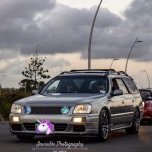The correct brake rotors/pads for WGNC34 Series 1/1.5 RB25 non turbo
Announcements
-
Similar Content
-
Latest Posts
-
Dissimilar metal corrosion. Aluminium is less noble than steel/iron, and will corrode preferentially when in contact with it and a conductive solution (ie, wet road salt). Tends to suggest that those brackets should be made in steel for a shitty climate like the UK.
-
By drifter17a · Posted
Here is picture of the rear brackets again seeming to have eating itself or corrode or whatever. Can’t describe it , hope someone could explain this -
By drifter17a · Posted
No i am in the uk so maybe road salt etc but checked rear and same story where handbrake cable seems to have eaten part of the bracket. Have emailed alpha omega waiting for reply -
I've not looked at a GTR without the booster there. Is the hole and mount on the firewall not just the same as GTSt? I would have expected it to be. Nissan don't change panel stampings if they don't have to, and you'd think they'd just order/design the booster to mount to the same place.
-
They have all sorts of "failure" modes. When they are brand new, the can either be very very tight, or reasonably mobile. If they are reasonably mobile, you'll probably have a good start. If they are very tight, then they can catch/grab at every little motion, and they mark the ball or the outer race, tearing off whatever teflon lining is in the outer race, then they can rapidly degenerate from there. If they get wet, they can just rust. They are just steel and will turn red pretty quickly. Water can get in behind them and sit and cause them to become crunchy and then proceed to tear themselves up, as above. Same with grit and dirt. Manufacturers and OEMs of the arms that use them will tell you that because they are teflon lined (well, the good ones, anyway), you shouldn't grease them. If you do grease them, then the grease will catch any passing grit and dirt and hold it in place where it can cause damage. Race teams that have them will lubricate them thoroughly. They will also inspect them every 5 minutes and replace them every 10 minutes, if need be. Some manufacturers of arms will provide dust boots. These can help, but they are seldom perfect, and sometime just make the situation worse, being a place where crap can collect. I have made nappies for some of mine with PVC sheet and race tape, to try to minimise the access of crap. When they wear, you can get a tiny tiny amount of movement between the ball and the outer race. This will make clicking noises. It will also make the arm have "slop" in that the tiny amount of movement available at the inner end of an arm can cause a lot of movement out at the outer end. 0.05mm at 5mm from the pivot becomes 4mm 400mm away from the pivot. If they are too tight and binding, they impede the proper motion of the suspension arm and put loads into it and the rest of the suspension that are not supposed to be there, and can cause failure. Think broken welds, broken threaded sections on the adjustable parts, mounts ripped off the chassis, etc. All of these are possible, which is the main reason why they are essentially illegal on the road in Australia.
-


Recommended Posts
Create an account or sign in to comment
You need to be a member in order to leave a comment
Create an account
Sign up for a new account in our community. It's easy!
Register a new accountSign in
Already have an account? Sign in here.
Sign In Now